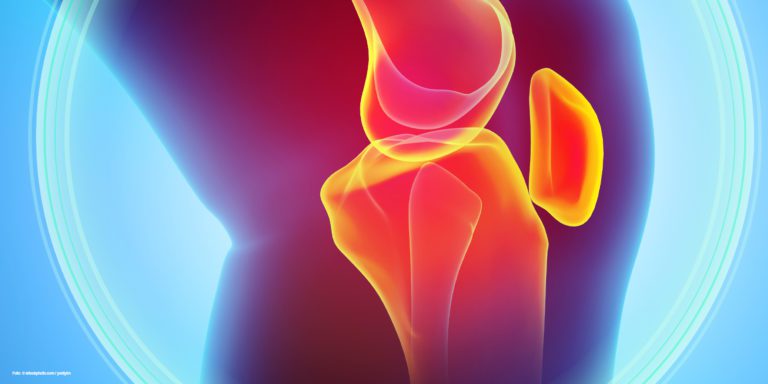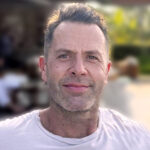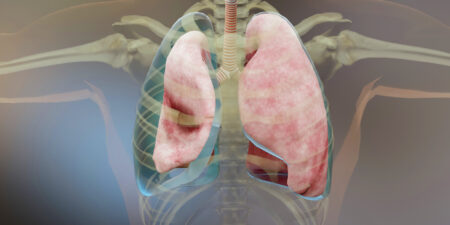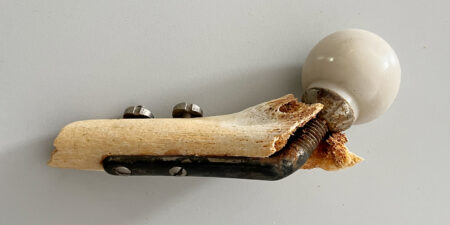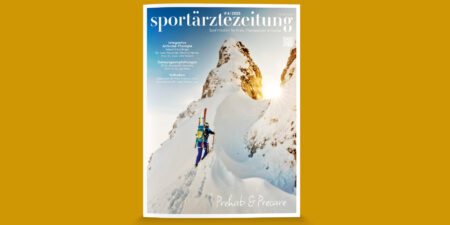The S2k guidelines on osteoarthritis of the knee (lead author: Prof. Dr. J. Stöve)
have an important and significant role in routine orthopaedic and sports medical practice and
are intended to provide key recommendations for doctors [1]. We already discussed this with
Prof. Dr. Stöve, Dr. Flechtenmacher, Dr. Ellermann and Prof. Dr. Herbort shortly after the guidelines
were published in 2018 (sportärztezeitung 04/18 „Experten-Talk Leitlinie Gonarthrose“[2]).
The guidelines, which are still valid until 29/11/2022, will be updated in the autumn. This topic area is a matter of special significance to us, particularly due to the many discussions we have had with our scientific advisors and other experts at our numerous continuing education sessions, at which users repeatedly came up with requests, providing us with new stimuli, starting points and tips, which we wish to pass on and share, thus offering support.
It is sufficiently well known that the potential of sports medicine has in no way been fully exploited. This applies equally to doing sport and targeted physical activity exercises in prevention/prophylaxis and therapy and to sports medical nutrition based on scientific principles. Dr. Patrick Müller, researcher at the German Centre for Neurodegenerative Diseases, Madgeburg, makes the point in the Deutschen Zeitschrift für Sportmedizin, for example, that “the fundamentally positive effects of physical activity and sport in the prevention and treatment of numerous chronic diseases have been scientifically proved. In this context, physical activity should be classified as a medicine with the highest level of evidence”. He also says that the potential of physical activity is still significantly underrepresented in the real world of healthcare [3]. In this respect sports medicine can make a contribution that benefits society as a whole regarding both therapeutic rehabilitation and prophylaxis/prevention. It is precisely now under the conditions of the Corona pandemic, which have no doubt entailed considerable difficulties and adjustments for everyone in our country, that sports medicine practitioners and therapists can make positive interventions at all levels – therapeutically, conservatively or surgically, rehabilitatively, prophylactically and nutritionally. This is precisely the best time to integrate sports medicine even more systematically into the real world of healthcare and to increase the benefit for all concerned, from doctors, therapists and sports scientists/trainers to the patients/athletes. This involves, in short, exercise as a subtype of sport, nutrition, conservative and surgical treatment options, prehabilitation, and also the implementation of mental and clinical psychological interventions including relaxation techniques. It is also the very combination of these individual areas, individually adjusted to the patient, that offers enormous potential and enhances the effect overall.
It is not a question of inventing something new. Rather, it is a matter of systematically and efficiently putting wellestablished strategies into clinical practice. A look at the guidelines for osteoarthritis of the knee reveals a plethora of useful and wonderful templates for the integration and implementation of further innovations and treatment concepts at all levels with the aid of sports medicine. This is precisely why we would like to use this to provide food for thought and thus also to urge practitioners to promote the individual application of the guidelines, use them as a meaningful decision aid and integrate them into routine sports medical practice.
Focus on basic topics
sport/exercise, weight management, nutrition medicine and inflammation as well as natural treatment as an accompanying measure to conservative treatment. Due to their complexity, we will dispense with comments and explanations regarding injections, PRP/ACP, hyaluron, blood derivatives/BCs and other conservative and surgical treatment options such as shock wave treatment, cryotherapy, laser, electrophysical therapies/TENS and other physical treatment options; their use is already adequately addressed and well presented in the guidelines for osteoarthritis of the knee. Nevertheless, it should be noted that there have also been extremely positive developments in these areas in particular, which reinforce discussions with our scientific advisors and insights from the current studies available (see also the update to the guidelines for osteoarthritis of the knee). Discussing all these topics here, however, would go beyond the scope of this paper, but they will be further discussed and presented in future articles and papers. We will therefore first address the basic topics stated above and discuss their potential and effects, thus allowing even more evidence-based, individualised and practice-oriented work in these areas.
The crucial role of the doctor and the interpretation of sports medicine and its practitioners should not be underestimated. Looking further afield, this is something that is also observed elsewhere. For example, the S2k guidelines for osteoarthritis of the hip (last revised 2019) point out that the recommendation of exercise therapy by a doctor is the decisive factor in motivating many patients to take up regular training [4]. It is very much the same with nutrition. Here too, doctors and, where applicable, therapists can – and should – make the required recommendation in order to really get things moving, for example regarding the positive effects of weight reduction/weight management (see also [5]). Whatever is recommended should always be agreed upon along with the athlete/patient, as they are ultimately the biggest part of the problem and its solution – compliance vs. “patient laziness”.
Weight management should be supported by concomitant exercise therapy, a change of diet and also nutritional supplements in accordance with the latest scientific findings in sports medicine. This applies especially to both top athletes who, particularly with regard to nutrition, also increase their performance potential by taking nutritional supplements, and above all to elderly patients. It also applies to hospitals, with preoperative and postoperative nutrition management that requires optimising and which, to make matters worse, is often outsourced for cost reasons. The optimised nutrition of elderly patients with protein and vitamin substitution is also indicated partly in accordance with sports medical guidelines for top athletes, particularly in terms of postaggression metabolism/postoperative recovery. This applies, incidentally, not just for the postoperative part but also for prehabilitation.
Weight management/nutrition
To underline the importance of nutrition in this context once again, we refer at this point to the statement made by Prof. Herbort in an expert talk on osteoarthritis of the knee in the sportärztezeitung (04/18) [2], which puts it in a nutshell:
“The topic of weight reduction is in my opinion one of the most important, but also one that is most frequently misunderstood and underestimated. The potential of weight reduction is often dismissed by patients as trivial. It should, however, be more or less the basis for many orthopaedic measures, as the effectiveness of both conservative and surgical measures is dramatically reduced if weight is not kept within normal limits. Osteoarthritis treatment seeks to compensate for the degenerative process in the joint, alleviating the symptoms despite sometimes massive degeneration. An important element of this compensation is most certainly mechanical loading, which is substantially influenced by body weight or the weight force. The biggest mistake in my opinion is just the trivialisation of the problem of weight and its treatment. Treatment should be conducted by professionals under interdisciplinary medical supervision and above all with support. The recommendation “to be simply be a little more disciplined “ should be considered negligent and frivolous.”
This issue is also an important factor particularly in osteoarthritis of the knee, as is also stated, for example, in the S3 guidelines for evidence and consensus-based indication criteria for total hip replacement in osteoarthritis of the hip. Here it is stated that although there is no direct evidence that weight reduction has an effect in osteoarthritis of the hip, an effect has been proved for osteoarthritis of the knee, which would therefore seem biomechanically plausible for osteoarthritis of the hip as well [6]. In the course of discussions and literature searches, we also came across a small practice-oriented Australian study in which it was shown that video-based, telemedical individualised training and weight loss programmes/meal replacement with online educational support improved pain and function in overweight or obese patients with osteoarthritis of the knee [7]. This is just one example of current work in modern weight management. In this context, a BIA measurement to record body composition might also be useful in connection with meal replacement, as shown in an as yet unpublished study by Dr Manfred Claussen on outpatient weight reduction in medical practice using meal replacement therapy (will be published in Current Nutrition Medicine, Thieme Verlag). The results of this study will be presented in the next newsletter of the sportärztezeitung.
These recommendations should of course also be implemented in orthopaedic and trauma surgery practices. We shall take a look here at an orthopaedic practice (MVZ OCP Kassel Lichtenau gGmbH) and the work as team doctor for MT Melsungen, a team in the German handball league, to give a small insight into what this can involve and how it can be done. In recent years, and particularly in elite sport, there has been a distinct increase in performance in both individual and team sports. The reasons are manifold: optimised training methods and regeneration cycles (which unfortunately are often not observed often enough in professional sports due to deadline pressure); the implementation of holistic athletics training; and improvements in sports physiotherapy and sports medical support, in terms of both orthopaedics, trauma surgery and general medicine and internal medicine/sports cardiology. Other performance-enhancing opportunities have also been achieved in recent years particularly for individually adjusted, sports nutritional reasons and have been implemented by many athletes, and especially by professional clubs with new nutrition concepts. In addition to nutrition optimisation in terms of content and time and the corresponding laboratory monitoring, targeted vitamin and trace element substitution, and especially also protein supplementation, are adjusted to the rhythm of both daily and seasonal competition. Of course, these sometimes also very costly measures in high-performance sports medicine are not directly transferable on a one-to-one basis to other areas (for example, elderly, multimorbid osteoporosis patients with a fracture of the femoral head). However, a large number of the aspects stated can also be implemented cost-effectively and for many patients, particularly the elderly. This includes preventive exercise therapy, including fall prevention for the elderly, and counselling for the overweight with a subsequent change of diet and weight reduction or, where applicable, protein supplementation. All of this can also be implemented at home and in old people’s homes, as well as in groups. Reference has already been made above to optimising nutrition for hospital patients. Orthopaedic and trauma surgery practices should most certainly provide patients, particularly those with symptoms of osteoarthritis of the knee and who are overweight, with advice about weight reduction, change of diet and exercise. In the latter case, for example, this might involve a change of sport (from the age of 55 onwards exercise more on a bicycle instead of only running), going to fitness studios and sports clubs, training at home with modern exercise therapy apps, such as Ortho Hero, available on prescription, and finally, of course, rehabilitation sport, which can also be prescribed by a doctor.
Natural Treatment First including phytopharmaceuticals, exercise and sport
At the same time, the further development of non-drug therapies should also be considered. Natural Treatment First, including phytopharmaceuticals, serves as a supplement and accompanying measure to traditional drug therapies and their use. With this expansion and the developments in this area, such options will be used in an even more targeted manner in future. In this respect, self- and home care in particular, always in consultation with the doctor and therapist, also has considerable potential to counteract drug misuse or also simply incorrect use. In recent months, more and more studies have been published on oral enzyme combinations and also in relation to undenatured type II collagen and other anti-inflammatory foods/phytopharmaceuticals and nutrition – an area which is continually growing and improving in quality. In overview, suitable and worth mentioning in this context are papers by Klein et al. (2006) [8], Egerton et al. (2022) [9] and the article by Pöttgen/Hotfiel on anti-inflammatory nutrition in the sportärztezeitung (2018) [10]. Equally worth recommending are papers by Liu et al. (2018) [11], and also the study initiated and already applied for by our advisor Dr Paul Klein and co-workers on the effect of the oral intake of UC-II on pain and function in patients with osteoarthritis of the knee compared to placebo. The initial results will be presented in the sportärztezeitung.
An even greater effect is achieved in combination with targeted sport (exercise), to which reference is made, amongst others, in the guidelines for osteoarthritis of the knee in subsection 5.2 Physiotherapy/exercise therapy, recommendation 1: “Exercise therapy measures for strength, endurance and mobility training should be used for the first-line treatment of osteoarthritis of the knee” [1]. Subsection 5.2.3 stresses the importance of combined programmes: “Exercise therapy interventions should be conducted in combination with educational interventions for pain relief“. [1] Patients should, however, receive professional guidance and the training must be individually adjusted, which falls within the scope of sports scientists and specialist physiotherapists. This is also stated, amongst others, in the guidelines for osteoarthritis of the hip: “Land-based exercise therapy is the core element of conservative, non-pharmacological treatment of osteoarthritis of the hip. Training should initially be conducted under the guidance of a physiotherapist or another professional group engaged in exercise therapy. Exercise therapy contributes to pain relief, improved function and quality of life in patients with osteoarthritis of the hip. (…) It is recommended to conduct training initially under professional guidance”. [4] Further on, it is stated in recommendation 4.4 that “Instruction should be given for self-management during training. This should include guidance in pain management skills and techniques, relaxation and encouragement to perform regular exercise (strong consensus)“ [4]. In Australia, exercise physiologists (exercise therapists), whose services are available on prescription, have been engaged as trainers/experts to excellent effect in the treatment of diseases that are sometimes even more serious than osteoarthritis, including even cancer, and are a further good option in the treatment strategy of patients.
The topic of sport and osteoarthritis of the knee in particular is, however, still often misrepresented. There is also increasing scientific evidence that targeted sports activity can be viewed as having a positive effect on the course of osteoarthritis of the knee. A longitudinal study, conducted as part of the OA initiative, has shown that jogging, for example, is not a factor driving osteoarthritis, but has in fact positive effects on pain development [12]. Even elderly osteoarthritis patients can accordingly still benefit from strength training of the lower extremity [13] and both pain and joint function can improve with targeted training [14]. The resulting improved quality of life and pain reduction in patients with osteoarthritis of the knee – without recourse to drugs or surgery – have been demonstrated in many meta-analyses [13, 14] and doctors and therapists should focus more on them. It is therefore our task to emphasise the positive link between sport and osteoarthritis of the knee and exhaust all the available modalities. It is particularly the combination of individualised training/sport and weight management and nutrition that provides the greatest opportunities for the treatment of osteoarthritis of the knee and hip. The new guidelines for osteoarthritis of the knee can be used for this purpose for the benefit of our patients.
Where the emphasis is put and which particular combination is meaningful and useful must always be determined anew in each individual case. The discussions between the doctor, therapist, trainer, patient and athlete play a particularly decisive role here. The aim of the uniform assessment standard (EBM) 2020 is to promote better doctor-patient communication. However, to many doctors in clinical practice it is not completely clear how they can invoice this “verbal medicine” in accordance with the statutory scale of fees for physicians (GOÄ) and the EBM. Good invoicing options are available, however, to which the German Association of Medical Practitioners in Private Practice (Virchowbund) refers [15]. The guidelines for osteoarthritis of the knee provide sufficient leeway in their high-quality explanations – this must be specifically implemented in clinical practice and then expanded and supplemented, where appropriate, with new findings from science and practice. All parties are urged to follow this course. Let us continue to support the guidelines (both the current and updated guidelines for osteoarthritis of the knee) and the outstanding work by the doctors contributing to them, learn from one another, make connections and further develop the real world of healthcare with good sports medical therapy. It is our mission to provide even more specific recommendations for action in these areas.
Literatur
[1] S2k-Leitlinie Gonarthrose (Federführender Autor: Prof. Dr. J. Stöve), Stand 18.01.2018
[2] Stöve, Ellermann, Flechtenmacher, Herbort „Leitlinie Gonarthrose – Ein Gespräch unter Experten“ sportärztezeitung 04 /18, S. 6 –15.
[3] Müller P et al. 2021 Physical Activity, Aging and Brain Health. Dtsch Z Sportmed. 2021;72: 327–334. doi:10.5960 /dzsm.2021.506
[4] S2k-Leitlinie Koxarthrose (Federführender Autor: Prof. Dr. G. Matziolis), Stand 08.07.2019
[5] McRae M, Hancock M 2017 Adults attending private physiotherapy practices seek diagnosis, pain relief, improved function, education and prevention: a survey. Journal of Physiotherapy, 63, Issue 4, October 2017, p. 250 –256
[6] S3-Leitlinie Evidenz- und konsensbasierte Indikationskriterien zur Hüfttotalendoprothese bei Coxarthrose (Federführende Fachgesellschaft: DGOU), Stand 24.03.2021
[7] Kim L. Bennell, et al. 2021 Comparing Video-Based, Telehealth-Delivered Exercise and Weight Loss Programs With Online Education on Outcomes of Knee Osteoarthritis – A Randomized Trial. Annals of Internal Medicine (2021: Doi: 10.7326 /M21-2388)
[8] Klein G et al. 2006 Efficacy and tolerance of an oral enzyme combination in painful osteoarthritis of the hip. A double-blind, randomised study comparing oral enzymes with non-steroidal anti-inflammatory drugs. Clin Exp Rheumatol.2006;24(1):25 – 30.
[9] Egerton T et al. 2022 Expert-Moderated Peer-to-Peer Online Support Group for People With Knee Osteoarthritis: Mixed Methods Randomized Controlled Pilot and Feasibility Study. JMIR Form Res 2022;6(1):e32627
[10] öttgen K, Hotfiel T „Alternative zu NSAR/Schmerzmittel – Einsatz und Potenziale entzündungshemmender pflanzlicher Nahrungsergänzung“ sportärztezeitung 03 /18, S.84 – 89
[11] Liu et al. 2018 Dietary supplements for treating osteoarthritis: a systematic review and meta-analysis. Br J Sports Med 2018 52(3):167–175. doi: 10.1136/bjsports-2016-097333.
[12] Lo GH, Musa SM, Driban JB, Kriska AM, McAlindon TE, Souza RB, Petersen NJ, Storti KL, Eaton CB, Hochberg MC, Jackson RD, Kwoh CK, Nevitt MC, Suarez-Almazor ME. Running does not increase symptoms or structural progression in people with knee osteoarthritis: data from the osteoarthritis initiative. Clin Rheumatol. 2018 Sep;37(9):2497–2504.
[13] Liao CD, Chen HC, Kuo YC, Tsauo JY, Huang SW, Liou TH. Effects of Muscle Strength Training on Muscle Mass Gain and Hypertrophy in Older Adults With Osteoarthritis: A Systematic Review and Meta-Analysis. Arthritis Care Res (Hoboken). 2020 Dec;72(12):1703-1718.
[14] Goh SL, Persson MSM, Stocks J, Hou Y, Welton NJ, Lin J, Hall MC, Doherty M, Zhang W. Relative Efficacy of Different Exercises for Pain, Function, Performance and Quality of Life in Knee and Hip Osteoarthritis: Systematic Review and Network Meta-Analysis. Sports Med. 2019 May;49(5):743-761.
[15] So können Sie sprechende Medizin nach GOÄ und EBM abrechnen 2019. Virchowbund. https://www.virchowbund.de/praxisaerzte-blog/so-koennen-sie-sprechende-medizin-nach-goae-und-ebm-abrechnen
Autoren
ist Diplom-Sportwissenschaftler mit Professional Master’s Degree in Sports Medicine sowie postgradualen Weiterbildungen in Mind-Body-Medizin (Harvard Medical School), Psychoneuroimmunologie und Lifestyle Medicine (American College of Lifestyle Medicine); Verleger der sportärztezeitung.
is a certified sports scientist with a professional master's degree in sports medicine and postgraduate training in mind-body medicine (Harvard Medical School), psychoneuroimmunology, and lifestyle medicine (American College of Lifestyle Medicine); publisher of the sportärztezeitung.
ist Facharzt für Orthopädie und Unfallchirurgie. Der Sportmediziner und Chiropraktiker hat eine Zulassung als Durchgangsarzt (D-Arzt) und ist Mitinhaber der Orthopädisch chirurgischen Gemeinschaftspraxis und Praxisklinik OCP Kassel mit dem Schwerpunkt ambulante Operationen. Außerdem betreut Dr. Rauch die 1. Bundesliga Handballmannschaft MT-Melsungen, war gewählter Kongresspräsident des größten europäischen orthopädisch-unfallchirurgischen Kongresses DKOU 2018 in Berlin und wiss. Beirat der sportärztezeitung.
ist Facharzt für Orthopädie und Unfallchirurgie und ärztlicher Leiter des UKE Athleticum am Universitätsklinikum Hamburg Eppendorf. Er hat seit 2021 eine Professur für Orthopädische Sportmedizin am UKE. Außerdem ist er leitender
Mannschaftsarzt der HSV Fußball AG. Sein klinischer Fokus liegt im Bereich der regenerativen Knorpeltherapie, der Behandlung von Sportverletzungen und Überlastungsschäden. Prof. Welsch ist wiss. Beirat der sportärztezeitung.
